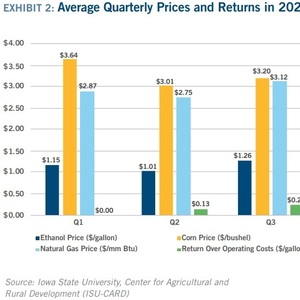CoBank predicts stable outlook for ethanol over next 2 quarters

October 13, 2020
BY Erin Krueger
The U.S. ethanol industry experienced some incremental positives during the third quarter and continued to recover to a new baseline level equaling roughly 90 percent of pre-COVID-19 demand, according to a quarterly report released by CoBank on Oct. 8. The near-term outlook for ethanol is stable.
The overall U.S. economy has been improving since late spring, but progress has slowed measurably, CoBank said, stressing that the economy remains fragile. Another broad fiscal relief package appears to be off the table—at least in the near-term, CoBank added, which means the currently sluggish economy will likely end the year in a fizzle.
CoBank’s report shows rural America is experiencing a dichotomy of improving industry fundamentals and a surge of COVID-19 cases.
Advertisement
“The good news, at least from an economic standpoint, is that many rural industries have begun to turn the corner,” said Dan Kowalski, vice president of CoBank’s Knowledge Exchange division. “This is particularly true in agriculture. A weaker, steady dollar has supported a price recovery in most agricultural commodities. And despite the myriad of challenges they’ve faced in 2020, essential rural industries are finding new ways to survive and, in some cases, thrive.”
For ethanol, CoBank cites data published by the U.S. Energy Information Administration that shows on an annualized basis, weekly U.S. ethanol production averaged 14.2 billion gallons for the third quarter, 89 percent of the first quarter’s average production of 15.9 billion gallons.
Advertisement
Analysis shows a typical dry milling fuel ethanol plant in Iowa experienced improved operating margins during the third quarter, averaging 21 cents per gallon, up from break-even margins experienced during the first quarter. CoBank said the improvement occurred as supply and demand became more balanced, and active producers benefitted from better productivity.
CoBank also cites the recently introduced Next Generation Fuels Act, the U.S. EPA’s denial of several gap year small refinery exemptions (SRE) petitions, and Brazil’s decision to allow duty-free imports of U.S. ethanol for 90 days as new developments that are supporting the ethanol industry. There is also potential for financial relief for the biofuels sector in the next COVID-19 relief bill, CoBank said. In addition, supply and demand remain in relative balance at current production levels.
The outlook for the ethanol industry is stable for the next two quarters, CoBank said, assuming the economy does not experience a double dip. CoBank said its outlook assumes continued high unemployment levels and below average consumer miles driven and noted its outlook could become more bullish if new COVID-19 cases drastically decline and/or an effective COVID-19 vaccine is rapidly produced and widely administered.
A full copy of the quarterly report can be downloaded from the CoBank website.
Related Stories
U.S. fuel ethanol capacity fell slightly in April, while biodiesel and renewable diesel capacity held steady, according to data released by the U.S. EIA on June 30. Feedstock consumption was down when compared to the previous month.
XCF Global Inc. on July 8 provided a production update on its flagship New Rise Reno facility, underscoring that the plant has successfully produced SAF, renewable diesel, and renewable naphtha during its initial ramp-up.
The USDA’s Risk Management Agency is implementing multiple changes to the Camelina pilot insurance program for the 2026 and succeeding crop years. The changes will expand coverage options and provide greater flexibility for producers.
EcoCeres Inc. has signed a multi-year agreement to supply British Airways with sustainable aviation fuel (SAF). The fuel will be produced from 100% waste-based biomass feedstock, such as used cooking oil (UCO).
SAF Magazine and the Commercial Aviation Alternative Fuels Initiative announced the preliminary agenda for the North American SAF Conference and Expo, being held Sept. 22-24 at the Minneapolis Convention Center in Minneapolis, Minnesota.
Upcoming Events










